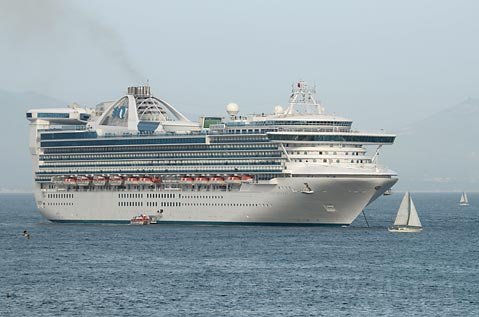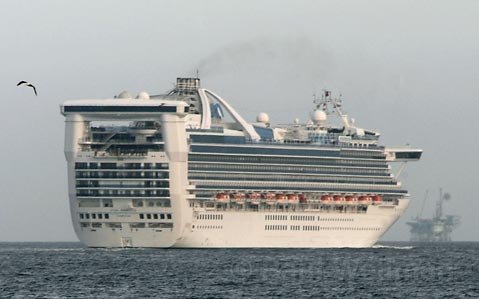Wastewater in Seawater
EPA Proposes Ban on Sewage Dumps Close to State's Shores

A proposed rule signed by the Environmental Protection Agency this week aims to prevent large ships from dumping sewage within three miles of California’s coastline. The rule, if enacted in the coming months, would stop millions of gallons of waste from making its way into sensitive ocean ecosystems and would complement the recently adopted discharge ban around the state’s national marine sanctuaries.
On Wednesday, August 25, EPA regional administrator Jared Blumenfield signed the proposal during a ceremony in San Francisco, paving the way for the largest “no-discharge zone” in the United States. All 1,624 miles of California’s coast — a total of 5,222 square miles — would be off limits. The ban targets cruise and cargo ships weighing 300 tons or more as well as any vessel that has a two-day wastewater storage capacity.
Ships would have to travel beyond the three-mile limit before their crews could unload waste, whether treated or untreated, the idea being that sewage dilutes better in deeper waters. Boats also typically travel faster as they move away from land, so the offloads could ideally be spread over a distance, not dumped in one concentrated area. The rule looks to protect not only open ocean coastline, but also tidally influenced bays, estuaries, and rivers.
The EPA estimates that about 25.4 million gallons of sewage are generated in state waters each year. The ban, said officials, could prohibit the release of approximately 80 percent — or 20.4 million gallons — of that amount in state waters yearly. Boats caught jettisoning refuse within the zone would be forced to pay a fine or be subjected to other enforcement action, courtesy of the Coast Guard.
“California’s coastal waters are a unique national treasure,” Blumenfield said. “The clear waters of the Pacific are central to California’s economic and ecological vitality. Stopping 20 million gallons of sewage … protects people and wildlife from dangerous pathogens.” An EPA press statement noted that while there are significant regulations for land-based municipal sewage release and stormwater runoff, vessel waste has not received the same level of attention until now.

Of the 434 state beaches monitored last year, 40 percent were subject to advisories because they exceeding safe pathogen levels; the adoption of the no-discharge zone, said officials, would likely cut down on the percentage. In that vein, legislators are hopeful the ban will have a directly positive impact on the Golden State’s economy because clean, open beaches mean more tourists and clear water means better fishing.
After the proposed rule was signed on Wednesday, explained Paul Amato with the EPA, it made its way over to the federal registrar’s office where it will be posted for a 60-day public comment period. Amato said the agency hopes to prepare and issue final regulation in early 2011. Once it’s signed, the ban will immediately take effect. The EPA, explained Amato, developed the rule in response to a request from the State Water Resources Control Board, and it’s in accordance with the 2005 Clean Coast Act.
Friends of the Earth campaign director Marcie Keever stated: “Big ships make for big pollution, but unfortunately responsible disposal of sewage from ships hasn’t always been a given in California. The actions taken by the U.S. EPA … mean that cruise lines and the shipping industry can no longer use California’s valuable coastal and bay waters as their toilet.”
So far, said Amato, the rule has seen a lot of support. All 20 of California’s congressional representatives have written letters to the EPA’s top administrator, Lisa Jackson, encouraging her to officially endorse the ban, water board agencies are completely behind the idea, and as far as the public is concerned, said Amato, people are simply curious what’s taken so long. “Folks wonder why it hasn’t happened yet,” he said.
The cruise ship industry likely won’t generate too much opposition, he went on, explaining that many companies already do deep water releases. Princess Cruises — whose ships, one or twice a year, grace Santa Barbara’s coastline — reportedly won’t feel any impact at all.
A spokesperson for the company said the Princess vessels don’t discharge any foulness in state waters, and the cruise line “adheres to all U.S. and international environmental regulations regarding the discharge of both ‘grey water’ (from showers, sinks, dishwashers) and ‘black water’ (from toilets) into the ocean.” Boats even go as far as 12 miles offshore to release refuse, the spokesperson said, which exceeds the distance required by current law.
What the commercial shipping industry thinks about the rule is another story, said Amato. “The jury is still out,” he said. While the EPA doesn’t expect any dramatic assault on the proposal, cargo ship companies could very well ask for a bit of tweaking. Calls to a few corporations had not been returned as of press time.
Naval ships would also fall under the ban’s parameters, explained Amato, as the proposal’s language does not offer the military a specific exemption. However, the Department of Defense can override the rule if the requirements get in the way of national security.
How the pending no-discharge zone could affect Santa Barbara boating operations is unclear at this time. Calls to local businesses that offer multi-day trips — and whose vessels presumably have sewage capacities of two days or more, making them subject to the proposed guidelines — had not been returned as of press time.



